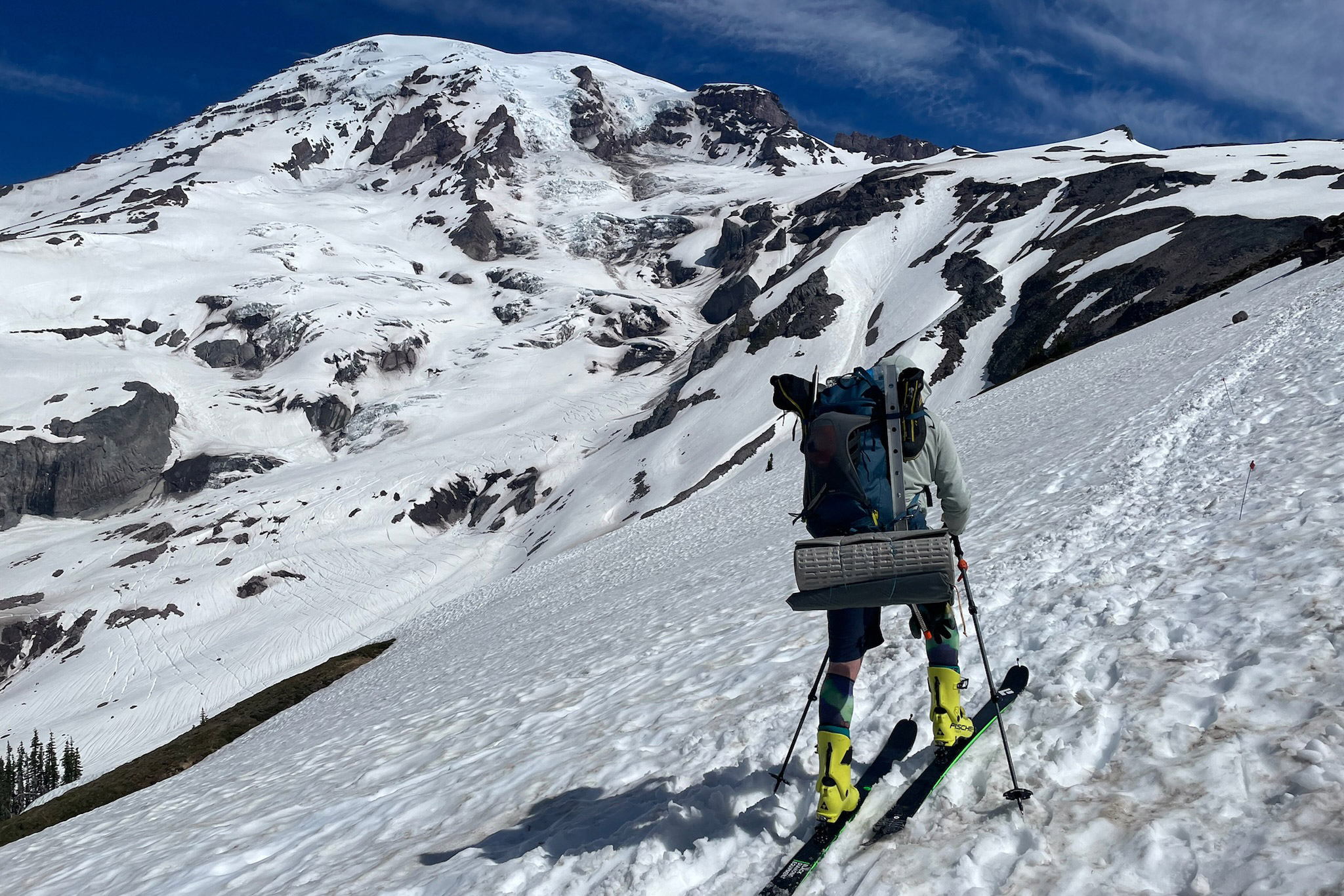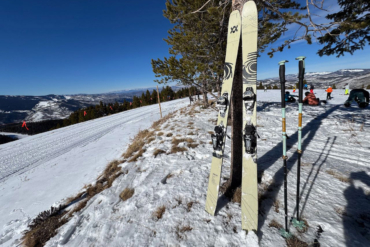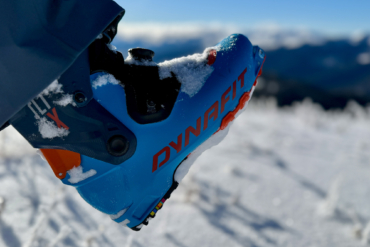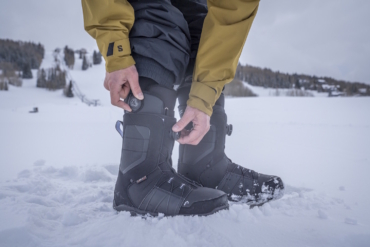The snow was softening in the early afternoon sun as school bus-sized blocks of ice loosened within the icefalls below us. My hand was cinched around the head of my ice axe as my two rope partners and I descended through an intimidating pitch of one of Mount Rainier’s crumbling glaciers.
I could hear bowling ball blocks of ice peeling off and tumbling to their demise deep in the heart of the mountain’s crevasses. The mountain was alive. I could feel my heart beating in my forehead as a blanket of stress sloshed over me.

But I took a breath and looked out over the horizon toward the ocean 13,000 feet below me. It was refreshing to take my eyes off my crampon points and the sheer drops on either side. We were still so high up on Mount Rainier, the view of my life lay in front of us. And for a moment, between bouts of exhaustion and anxiety, I felt the intoxication that addicts mountaineers of all levels to the Cascade Range in Washington.
My two climbing partners, Eddie and Griff, walked steadily down the ice sheet, careful not to botch a step. We’d been eyeing an ascent of Mount Rainier for 4 years from afar, imagining the summit above the clouds and the slow sunrise over the icy crater.
We’d also been dialing in the skills to navigate the glacier’s intricacies. And we’d finally made it, to turn that dream into a reality.
Mount Rainier was our second Cascade summit of the week after Mount Baker, and this was the far more challenging of the two. Climbing one of these Northwest Volcanoes, like Mount Rainier or Baker is hard. But it’s not out of reach of anyone willing to put in the work, build experience, and get the training.
In fact, there’s a volcano and a route here for you if you’ve got the will to come find it. Here’s a few of the things I learned from my first ascent on Mount Rainier — the one that hooked me.
Mountaineering in the Cascades: Getting Hooked
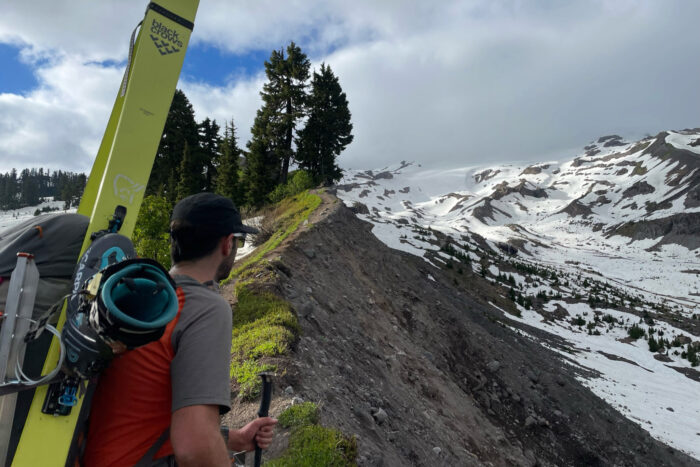
The Approach From Mount Rainier National Park
If you’ve been to Seattle, you know Mount Rainier. It looms behind the city, a surreal monster dominating an otherwise mellow skyline. It’s hard to imagine what standing on the top would feel like.
We hit the permit office in Mount Rainier National Park as it opened at 8 a.m. after spending the night in the Whittaker Lodge just outside the park entrance. All climbers are required to secure a Mount Rainier climbing permit in person and pay an annual climbing fee ($65/person in 2023).
It’s a straightforward process. But it gives Climbing Rangers at Mount Rainier National Park the opportunity to vet climbers, their experience, and their safety systems before they set out.
The approach had thus begun as the morning sun refracted from the alpine ice.
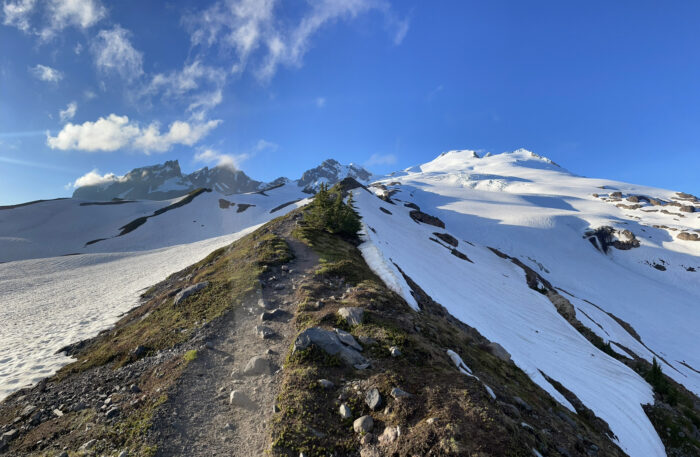
From here, it was over 4,000 feet up the non-glaciated Muir Snowfield to Camp Muir, the mid-camp of the standard route up Rainier. It’s the first test of strength and will. It’s the heaviest that all the climbing hardware, tent, and other gear would feel as we trudged upward through softening snow.
Preparation, like most mountain endeavors, is what brings success to a climb on one of these beasts regardless if it’s a standard route or something more technical. They’re a level up from a typical peak in Colorado, for example. Most of these glaciated volcanos take at least 2 days — and sometimes up to 4 — for the average climber. We were aiming to complete Mount Rainier in just 2. And we were carrying an armory of gear to get us to the top.
The Gear
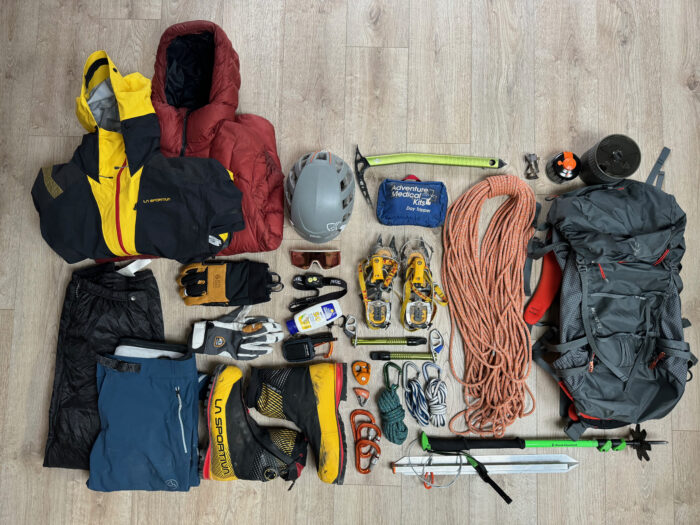
Gear selection and prep is an intricate practice when you’re approaching a mission like this one. Finding a kit that strikes the right balance between light weight, durability, protection, and being ready for the unpredictable is the ultimate goal. Gear lists are easy to find online. You learn quickly what works for you and what doesn’t.
The technical side of the list is what separates Cascade volcano climbing from other big peaks in the U.S. It starts with an ice axe and a climbing helmet. Then come steel crampons and some boots that will accommodate them. I brought along my trusty Grivel G12s and my La Sportiva G5 Evo boots.
Every mountaineer will tell you that boots are not the place to skimp. It’s critical to have boots that are both warm enough for the coldest possible temperatures that you’ll encounter, stiff enough to securely accommodate your crampons, and comfortable enough for long days on your feet with a heavy pack.
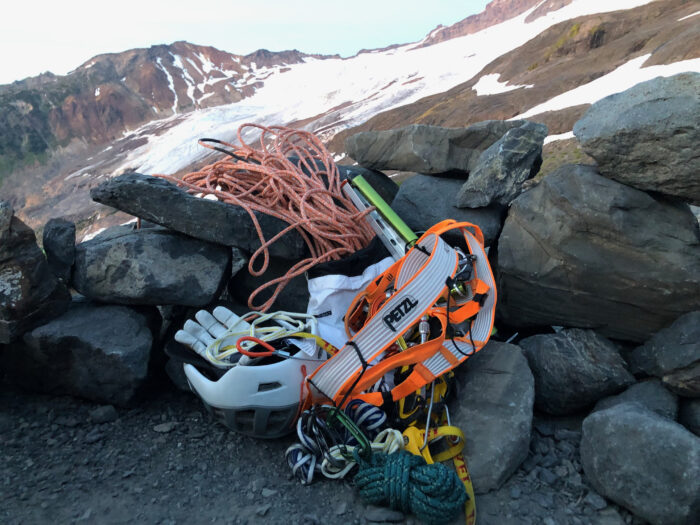
Next comes the rescue system. These days, Petzl’s micro traxion and tibloc, paired with a rope, slings, prusik cord, locking carabiners, and a climbing harness keeps things light and tidy. Each climber should have a snow picket and an ice screw for anchor building. And an extra pulley or two never hurts.
Then it’s all about layers and there are unlimited combinations. At the very least each climber needs a waterproof shell top and bottom, an ultra-warm puffy jacket, three pairs of gloves of different weights, a midlayer, baselayers, warm socks, a hat, and a buff. Warm layers are also not a place to cut corners — it’s cold up there!
Then stuff it all into a 50L (plus) backpack with a (preferably 4-season) tent, sufficient sleeping bag, sleeping pad, and the other odds and ends, plus food and water, and start hauling it uphill.
Fitness Equals Safety
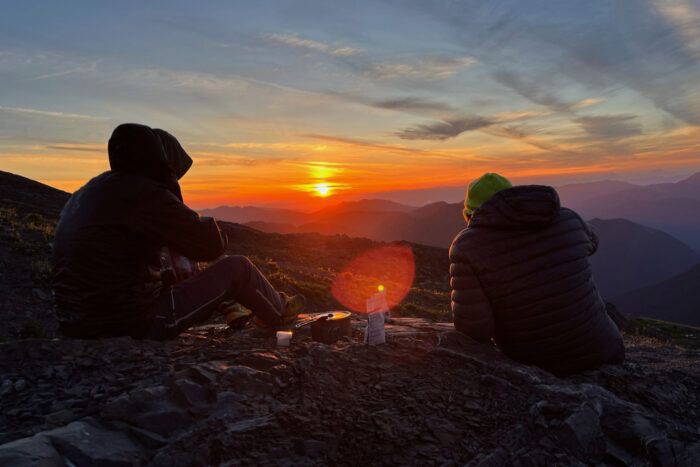
Fitness is the obvious first test when attempting to climb a Cascade volcano; vertical gain and a heavy pack loaded with all that gear, the obstacles. Underestimating either is a mistake. Even for strong backpackers, hoofing it 8,000-9,000 vertical feet with a 50-pound pack is a major commitment.
Climbing mountains in Colorado, lots of squats, and a healthy dose of trail running proved a solid foundation for me to climb from. My climbing partners, strong mountain athletes in their own right, got away with a fraction of that.
For a climb like this, though, better fitness means a higher margin of safety. The stronger you and your team are, the easier it will be to think critically while exhausted, make good decisions late in the day, haul a partner out of a crevasse, and support your team.
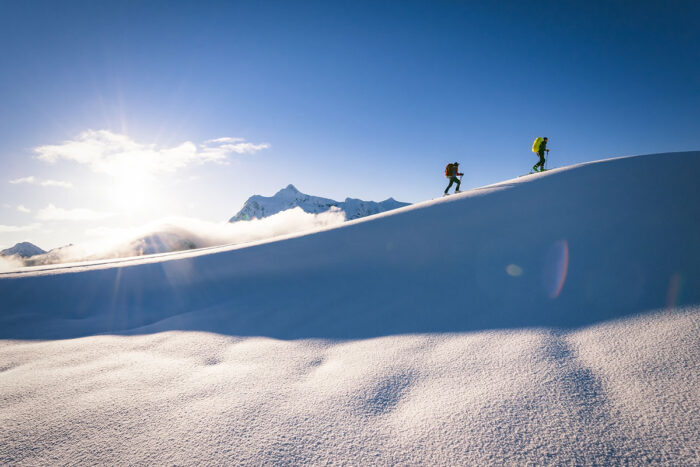
You land at mid-camp after 3 to 6 hours tired and probably baked from the sun and albedo.
Setting up a tent on snow in an environment known for flattening tents like a house of cards can be challenging. Having some basic winter camping skills goes a long way when you’re sleeping on a glacier. (More on that below.) Then it’s all melting snow for water. Did you bring enough fuel for a thirsty team?
We sure didn’t.
Some Technical Skills Required

The rope, rescue, and movement skills are what separate the demands of the Cascades from other peaks in the lower 48. Lacking any one of them before getting on the high pitches of a mountain like Mount Rainier or Baker is asking for trouble. They’re not to be taken lightly. It’s one of the reasons many first-time climbers hire a guide or join a guided group.
“You probably can only gain experience in the North Cascades for North Cascades climbs — perhaps Alaska too. So if you’re coming from out of state [in the lower 48], you definitely want a guide,” said Janow, when I asked him about skills that transfer from other mountains. “Your skills built on Shasta, Whitney, and in Colorado may not be exactly what you need.”
Tent Camping in Snow
With so much wind and melting snow, tent stakes are basically useless. Knowing your snow anchors, like a deadman, is critical for keeping your tent stuck to the ground. That’s where you tie a guy line to a bulky object, like a stuff sack full of snow, a big stick, a rock, or even a big sideways tent stake, and bury it under the snow and pack it down.
An “I” anchor is another option if you’ve got skis, poles, or an extra ice axe to plunge into the snow vertically and tie off to. They’re quicker to construct and deconstruct for slightly less security than a deadman.
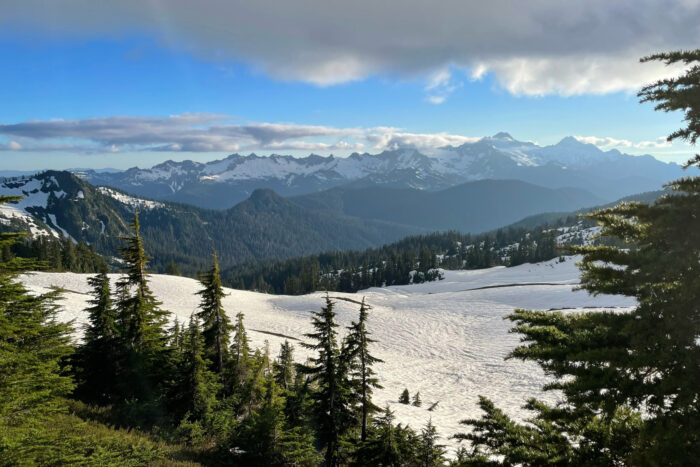
Fancy Footwork
Summit day means clomping around in crampons for the entire day. This isn’t the place to try walking in crampons for the first time. It takes some getting used to. Tripping over a frontpoint or snagging a tooth on your pant cuff is an inevitable part of the learning process. The consequences of tripping multiply the minute you’re standing on a sloped glacier.
Dialing in your footwork, from French to American style could be the most important safety skill in all of crampon-dependent endeavors. It’s not as simple as just walking uphill, given that mountaineering boots and crampons are more or less rigid.
The “style” depends on the pitch. Steep ice requires front pointing, but your calves will burn. French technique, or crossover step, is more of an uphill sidestep for steep slopes, utilizing the crampons’ side teeth which is easier, but slower. It’s a lot like walking up a set of stairs sideways. American style is a mix of the two — one foot front points while the other moves uphill sideways to rest one calf at a time. Then there’s the intuitive duck walk and kick step for mellow slopes.
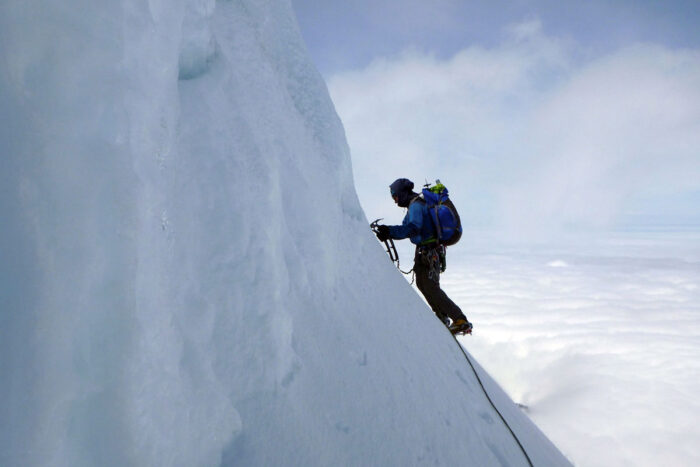
Self Arresting
Self arrest is the ability to catch a slip before it becomes a fall, using a orchestrated mixture of ice axe and crampons. Whether you’re sliding upside down, right side up, or tangled in a rope, the ability to get righted and stop the slide is what keeps you and your rope team safe if anyone falls. The American Alpine Institute has a thorough webpage with self arrest techniques. But this is another critical skill best learned with professional guidance.
Logically speaking, tying in with other climbers means a slip from anyone puts everyone at risk. So, why bother if you’ve got solid footwork down? Crevasses, sometimes the size of an elementary school, are what separate glacier climbing from snow climbing. There’s no self arresting or coming back from an unroped fall into a big crevasse.
And as the summer wears on, snow bridges that build over crevasses throughout the winter begin to melt out. It’s not uncommon for a foot to punch through as the afternoon sun begins to warm the snow. The rope protects a climber from an irretrievable fall into one of these cracks.
Anchor Building and Hauling
It’s not as simple as pulling a fallen climber out of a crevasse with your sheer strength and grit, though. You aren’t strong enough. Plus, after a teammate falls in, you’ve just been volunteered as an anchor thanks to your diligent self arrest. This is where the most technical skill required for your average glaciated volcano comes into play: anchor building and hauling.
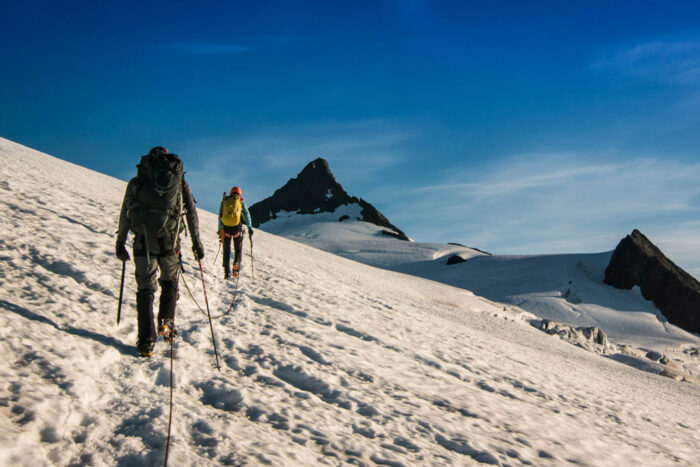
In a simple crevasse fall scenario where someone on the end of the rope falls into a crack, it’s up to the rest of the rope team to get them out. Everyone drops into self arrest and holds firm.
Someone, ideally closest to the fallen climber pounds in a snow picket at the right angle. Clip the rope to the cable. Ease off and transfer the load and prussik to the system. Carefully move to the lip of the crevasse to check on the fallen climber.
Are they conscious? Great, that makes it easier. Pad the lip with an axe. Fortify the anchor with another equalized picket. Free up the rest of the rope, attach a micro traxion with a locker and drop it to the fallen climber to attach to their belay loop.
Build a 3:1 with pulleys and tibloc or another prussik. Haul, but carefully and smoothly. With precision, your partner pops out unharmed.
Now add darkness, stress, freezing fingers, and possible injury. It’s not easy. The right training with professionals and actual practice over and over again is what makes it realistic for anyone to learn. The YouTube version of training will not inspire confidence from your teammates whose lives are in your hands.
The Climb
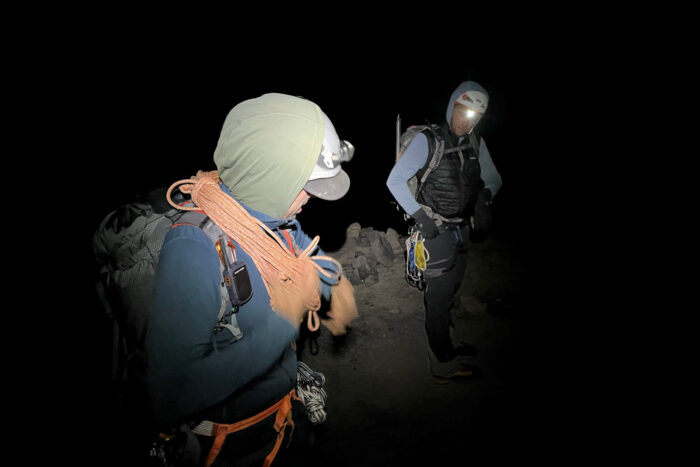
Anytime you set an alarm for 1 or 2 a.m., chances are you won’t sleep much. Add a handful to many dozen restless climbers camping around you and a pinch of anxiety, and you’re up snapping your crampons on before you’ve even dozed off.
There’s something special about an alpine start. A full moon, a calm breeze, the hollow crunch of crampon teeth in ice. The quiet eagerness of a team donning harnesses and taking their last comforting sips of instant coffee.
And all too quickly, you step onto the glacier tied in with your partners. From there, it’s at least 4 hours and another 4,000 vertical feet to the summit. Settle into a moderate pace; you’re only going as fast as the other teammates on your rope.
Hire a Guide or Join a Group
Even for a relatively straightforward route on a mountain like Mount Rainier or Baker, the success rate falls right around 50%. Logistics, weather, conditions, and the team align about as often as they don’t. Bailing when an ingredient is missing is just part of the process on mountains and conditions as dynamic as these.
Guide services are widely considered the best starting point for mountaineers aspiring to step up to glaciated peaks. They’re plentiful in the Northwest. I asked Gordon Janow, Alpine Ascents’ director of programs, for his thoughts on when it’s a good idea to hire a guide.
“For those starting out, we always suggest hiring a guide who understands the ever-changing conditions,” Janow said. “Most of the climbs have crevassed glacier crossings so even the experienced climber would benefit from having a guide on their first or second climb to get the lay of the land.”
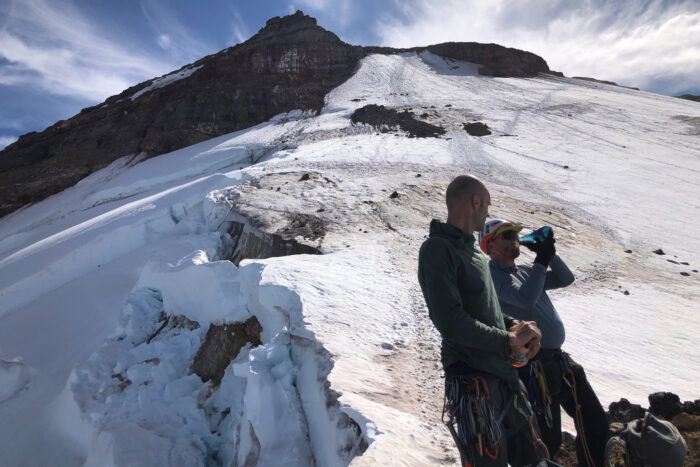
Guides can also help better identify conditions on unguided climbs up Mount Rainier or Baker, Janow added.
Guided ascents aren’t cheap, but they are one of the best ways to push your chances of success higher, especially for beginners or those with limited glacier experience.
“There are some great guides and guide services out here. So, it’s no problem finding a guide,” said Janow. “Joining a group on a three- or four-day climb of say [Mount] Baker or Shuksan is a good way to go and less expensive than a private guide,” he added.
Plus, grants and scholarships are growing in number to help address barriers to access including costs, travel, and know-how for more folks out there eager to give it a shot.
Whether it’s hiring a guide, joining a more experienced team, or piecing together skills and experience elsewhere, the Cascades boast an impressive array of routes for all abilities. It’s a range where there’s always something bigger, something worth coming back for.
The Final Push
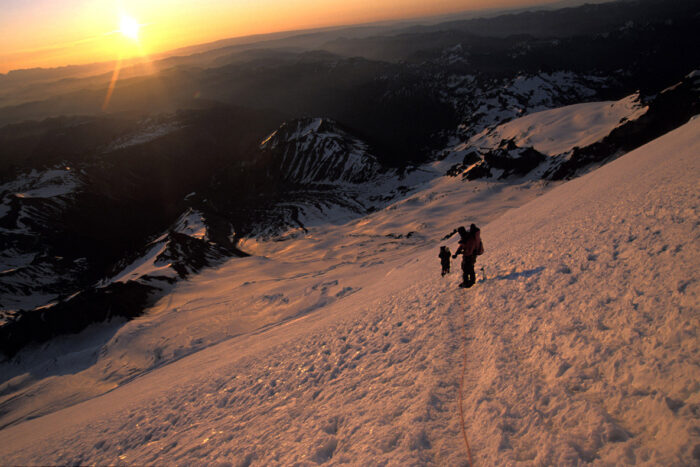
It’s somewhere along the summit ridge that the first beams of morning sunlight trickled over the mass of ice and rock; the first sign that the cold darkness had nearly passed. The first sign that warmth was just around the corner.
I looked back toward Seattle after crossing a small crevasse. It was the view I’d heard about so many times; the peak’s shadow cast miles to the west over a sea of glowing pink clouds. Only the other glacier capped volcanoes poked through in the distance, hundreds of miles away to the North and South.
From here, with the sun out high on the mountain, the summit is within striking distance. Just a few more crevasse crosses and icy pitches to ascend. That’s the halfway mark.
Before we knew it, we were on top, no longer imagining the summit from far below but experiencing it from on high.
North Cascades Volcanoes: Conclusion
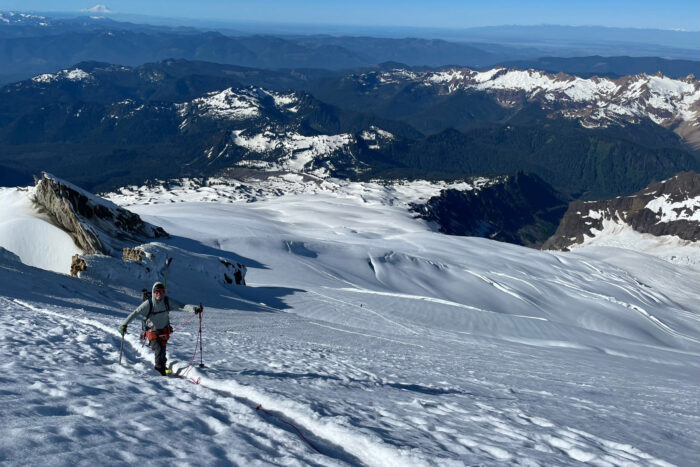
We’d been moving steadily upward from the parking lot, and now back down, for over 24 hours. Many more hours of descending lay in front of us. Yet the relief and sense of fulfillment was already burgeoning.
Climbing Mount Rainier and Mount Baker in Washington’s North Cascades, my first volcanoes, hooked me. There’s just something about these giants. The feeling of stumbling back to camp, tired and depleted, looking back at the massive crumbling glaciers and the high peak — there’s nothing like it. They continue to pull me back to the next peak, the next route. My Colorado-based climbing partners feel the immutable pull too.
These volcanoes are as challenging as they are rewarding. More importantly, they’re not out of reach of anyone willing to put in the work, to learn the ropes, and get strong. And even then, a guided ascent is a great place to start.
From there, a new world of mountaineering opportunity opens up. The Cascade Volcanoes are noteworthy objectives in their own right, of course. But they’re also stepping stones to even bigger peaks, more committing routes, and the greater ranges of faraway continents.
